Leadership and Management Report: Motivation and Teams
VerifiedAdded on 2020/07/22
|11
|2924
|67
Report
AI Summary
This report delves into the interconnected fields of leadership and management, exploring their distinct yet complementary roles in achieving organizational goals. It begins by defining the core concepts of leadership and management, highlighting the differences between leaders and managers, and then assesses key leadership theories, including trait theory, behavioral theory, and transformational leadership. The report also analyzes the challenges faced in various management and leadership practices, such as inspiring others, confronting performance issues, and developing managerial effectiveness. The second part of the report focuses on motivational theories, such as Hertzberg's two-factor theory, Maslow's hierarchy of needs, and expectancy theory, examining their influence on organizational success. It assesses the roles of leadership and management in worker motivation and evaluates the contribution of performance management techniques. Finally, the report explores the effectiveness and development of teams, evaluating the roles and models of team leadership and analyzing the role of teams within an organization. The report emphasizes the importance of effective leadership, motivation, and teamwork in achieving organizational objectives.
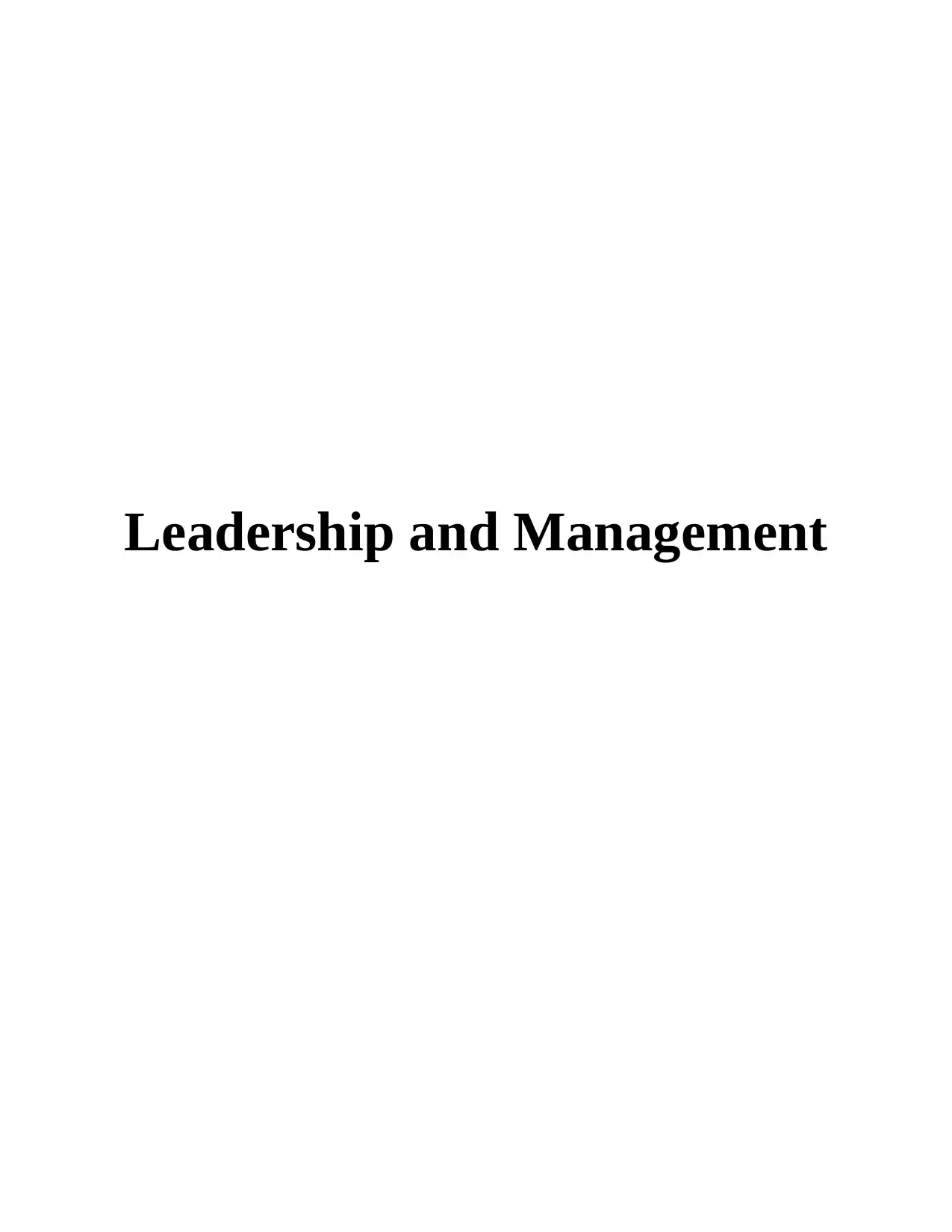
Leadership and Management
Paraphrase This Document
Need a fresh take? Get an instant paraphrase of this document with our AI Paraphraser
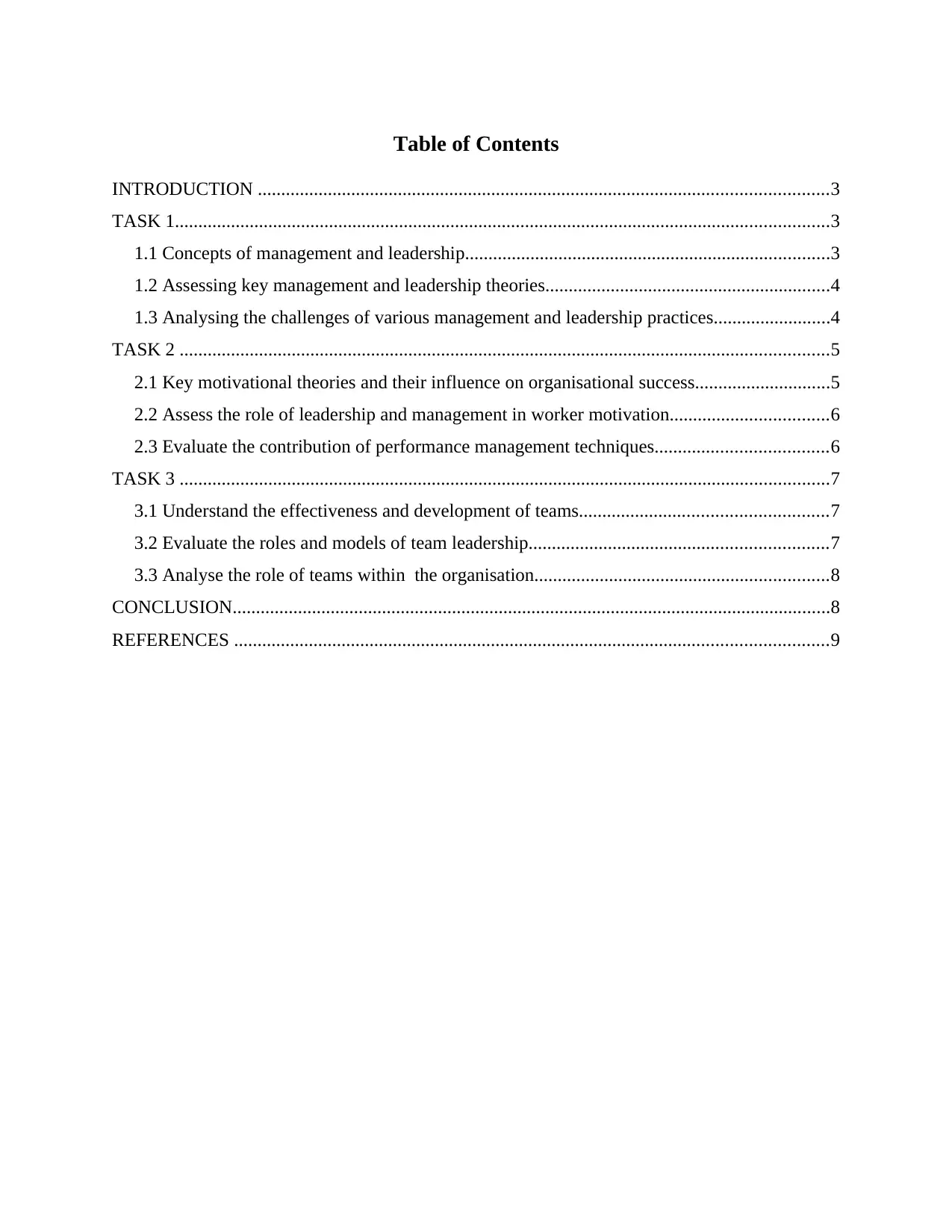
Table of Contents
INTRODUCTION ..........................................................................................................................3
TASK 1............................................................................................................................................3
1.1 Concepts of management and leadership..............................................................................3
1.2 Assessing key management and leadership theories.............................................................4
1.3 Analysing the challenges of various management and leadership practices.........................4
TASK 2 ...........................................................................................................................................5
2.1 Key motivational theories and their influence on organisational success.............................5
2.2 Assess the role of leadership and management in worker motivation..................................6
2.3 Evaluate the contribution of performance management techniques.....................................6
TASK 3 ...........................................................................................................................................7
3.1 Understand the effectiveness and development of teams.....................................................7
3.2 Evaluate the roles and models of team leadership................................................................7
3.3 Analyse the role of teams within the organisation...............................................................8
CONCLUSION................................................................................................................................8
REFERENCES ...............................................................................................................................9
INTRODUCTION ..........................................................................................................................3
TASK 1............................................................................................................................................3
1.1 Concepts of management and leadership..............................................................................3
1.2 Assessing key management and leadership theories.............................................................4
1.3 Analysing the challenges of various management and leadership practices.........................4
TASK 2 ...........................................................................................................................................5
2.1 Key motivational theories and their influence on organisational success.............................5
2.2 Assess the role of leadership and management in worker motivation..................................6
2.3 Evaluate the contribution of performance management techniques.....................................6
TASK 3 ...........................................................................................................................................7
3.1 Understand the effectiveness and development of teams.....................................................7
3.2 Evaluate the roles and models of team leadership................................................................7
3.3 Analyse the role of teams within the organisation...............................................................8
CONCLUSION................................................................................................................................8
REFERENCES ...............................................................................................................................9
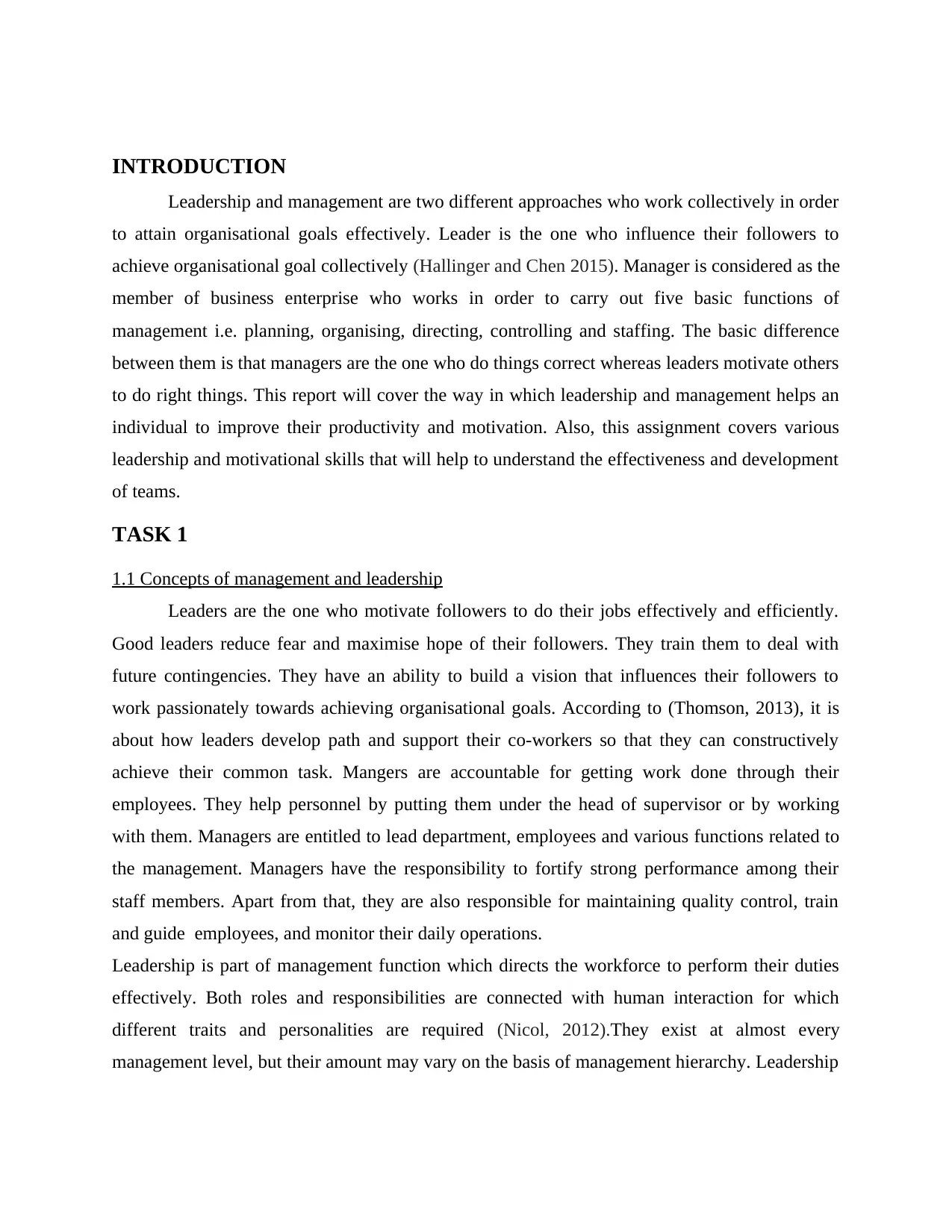
INTRODUCTION
Leadership and management are two different approaches who work collectively in order
to attain organisational goals effectively. Leader is the one who influence their followers to
achieve organisational goal collectively (Hallinger and Chen 2015). Manager is considered as the
member of business enterprise who works in order to carry out five basic functions of
management i.e. planning, organising, directing, controlling and staffing. The basic difference
between them is that managers are the one who do things correct whereas leaders motivate others
to do right things. This report will cover the way in which leadership and management helps an
individual to improve their productivity and motivation. Also, this assignment covers various
leadership and motivational skills that will help to understand the effectiveness and development
of teams.
TASK 1
1.1 Concepts of management and leadership
Leaders are the one who motivate followers to do their jobs effectively and efficiently.
Good leaders reduce fear and maximise hope of their followers. They train them to deal with
future contingencies. They have an ability to build a vision that influences their followers to
work passionately towards achieving organisational goals. According to (Thomson, 2013), it is
about how leaders develop path and support their co-workers so that they can constructively
achieve their common task. Mangers are accountable for getting work done through their
employees. They help personnel by putting them under the head of supervisor or by working
with them. Managers are entitled to lead department, employees and various functions related to
the management. Managers have the responsibility to fortify strong performance among their
staff members. Apart from that, they are also responsible for maintaining quality control, train
and guide employees, and monitor their daily operations.
Leadership is part of management function which directs the workforce to perform their duties
effectively. Both roles and responsibilities are connected with human interaction for which
different traits and personalities are required (Nicol, 2012).They exist at almost every
management level, but their amount may vary on the basis of management hierarchy. Leadership
Leadership and management are two different approaches who work collectively in order
to attain organisational goals effectively. Leader is the one who influence their followers to
achieve organisational goal collectively (Hallinger and Chen 2015). Manager is considered as the
member of business enterprise who works in order to carry out five basic functions of
management i.e. planning, organising, directing, controlling and staffing. The basic difference
between them is that managers are the one who do things correct whereas leaders motivate others
to do right things. This report will cover the way in which leadership and management helps an
individual to improve their productivity and motivation. Also, this assignment covers various
leadership and motivational skills that will help to understand the effectiveness and development
of teams.
TASK 1
1.1 Concepts of management and leadership
Leaders are the one who motivate followers to do their jobs effectively and efficiently.
Good leaders reduce fear and maximise hope of their followers. They train them to deal with
future contingencies. They have an ability to build a vision that influences their followers to
work passionately towards achieving organisational goals. According to (Thomson, 2013), it is
about how leaders develop path and support their co-workers so that they can constructively
achieve their common task. Mangers are accountable for getting work done through their
employees. They help personnel by putting them under the head of supervisor or by working
with them. Managers are entitled to lead department, employees and various functions related to
the management. Managers have the responsibility to fortify strong performance among their
staff members. Apart from that, they are also responsible for maintaining quality control, train
and guide employees, and monitor their daily operations.
Leadership is part of management function which directs the workforce to perform their duties
effectively. Both roles and responsibilities are connected with human interaction for which
different traits and personalities are required (Nicol, 2012).They exist at almost every
management level, but their amount may vary on the basis of management hierarchy. Leadership
⊘ This is a preview!⊘
Do you want full access?
Subscribe today to unlock all pages.

Trusted by 1+ million students worldwide
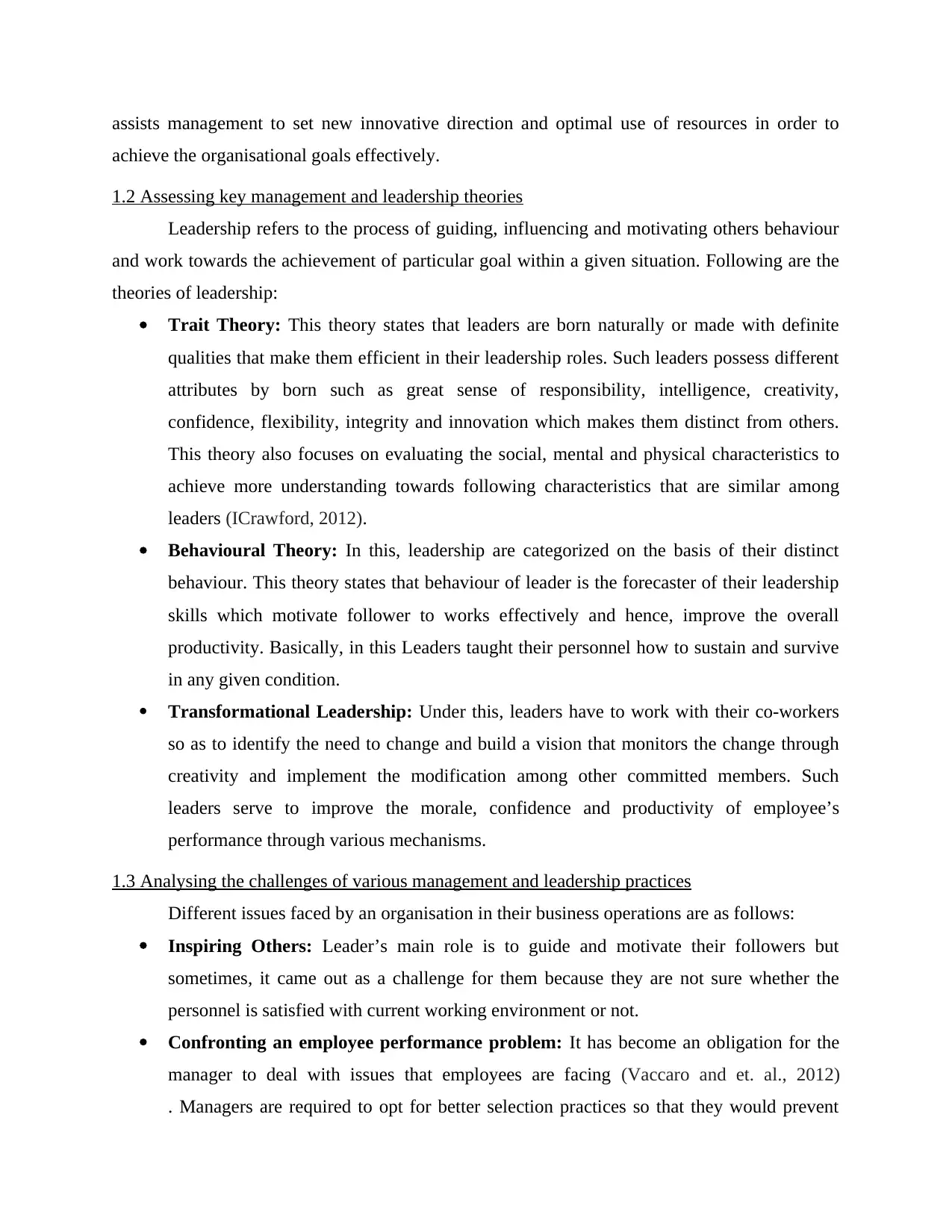
assists management to set new innovative direction and optimal use of resources in order to
achieve the organisational goals effectively.
1.2 Assessing key management and leadership theories
Leadership refers to the process of guiding, influencing and motivating others behaviour
and work towards the achievement of particular goal within a given situation. Following are the
theories of leadership:
Trait Theory: This theory states that leaders are born naturally or made with definite
qualities that make them efficient in their leadership roles. Such leaders possess different
attributes by born such as great sense of responsibility, intelligence, creativity,
confidence, flexibility, integrity and innovation which makes them distinct from others.
This theory also focuses on evaluating the social, mental and physical characteristics to
achieve more understanding towards following characteristics that are similar among
leaders (ICrawford, 2012).
Behavioural Theory: In this, leadership are categorized on the basis of their distinct
behaviour. This theory states that behaviour of leader is the forecaster of their leadership
skills which motivate follower to works effectively and hence, improve the overall
productivity. Basically, in this Leaders taught their personnel how to sustain and survive
in any given condition.
Transformational Leadership: Under this, leaders have to work with their co-workers
so as to identify the need to change and build a vision that monitors the change through
creativity and implement the modification among other committed members. Such
leaders serve to improve the morale, confidence and productivity of employee’s
performance through various mechanisms.
1.3 Analysing the challenges of various management and leadership practices
Different issues faced by an organisation in their business operations are as follows:
Inspiring Others: Leader’s main role is to guide and motivate their followers but
sometimes, it came out as a challenge for them because they are not sure whether the
personnel is satisfied with current working environment or not.
Confronting an employee performance problem: It has become an obligation for the
manager to deal with issues that employees are facing (Vaccaro and et. al., 2012)
. Managers are required to opt for better selection practices so that they would prevent
achieve the organisational goals effectively.
1.2 Assessing key management and leadership theories
Leadership refers to the process of guiding, influencing and motivating others behaviour
and work towards the achievement of particular goal within a given situation. Following are the
theories of leadership:
Trait Theory: This theory states that leaders are born naturally or made with definite
qualities that make them efficient in their leadership roles. Such leaders possess different
attributes by born such as great sense of responsibility, intelligence, creativity,
confidence, flexibility, integrity and innovation which makes them distinct from others.
This theory also focuses on evaluating the social, mental and physical characteristics to
achieve more understanding towards following characteristics that are similar among
leaders (ICrawford, 2012).
Behavioural Theory: In this, leadership are categorized on the basis of their distinct
behaviour. This theory states that behaviour of leader is the forecaster of their leadership
skills which motivate follower to works effectively and hence, improve the overall
productivity. Basically, in this Leaders taught their personnel how to sustain and survive
in any given condition.
Transformational Leadership: Under this, leaders have to work with their co-workers
so as to identify the need to change and build a vision that monitors the change through
creativity and implement the modification among other committed members. Such
leaders serve to improve the morale, confidence and productivity of employee’s
performance through various mechanisms.
1.3 Analysing the challenges of various management and leadership practices
Different issues faced by an organisation in their business operations are as follows:
Inspiring Others: Leader’s main role is to guide and motivate their followers but
sometimes, it came out as a challenge for them because they are not sure whether the
personnel is satisfied with current working environment or not.
Confronting an employee performance problem: It has become an obligation for the
manager to deal with issues that employees are facing (Vaccaro and et. al., 2012)
. Managers are required to opt for better selection practices so that they would prevent
Paraphrase This Document
Need a fresh take? Get an instant paraphrase of this document with our AI Paraphraser
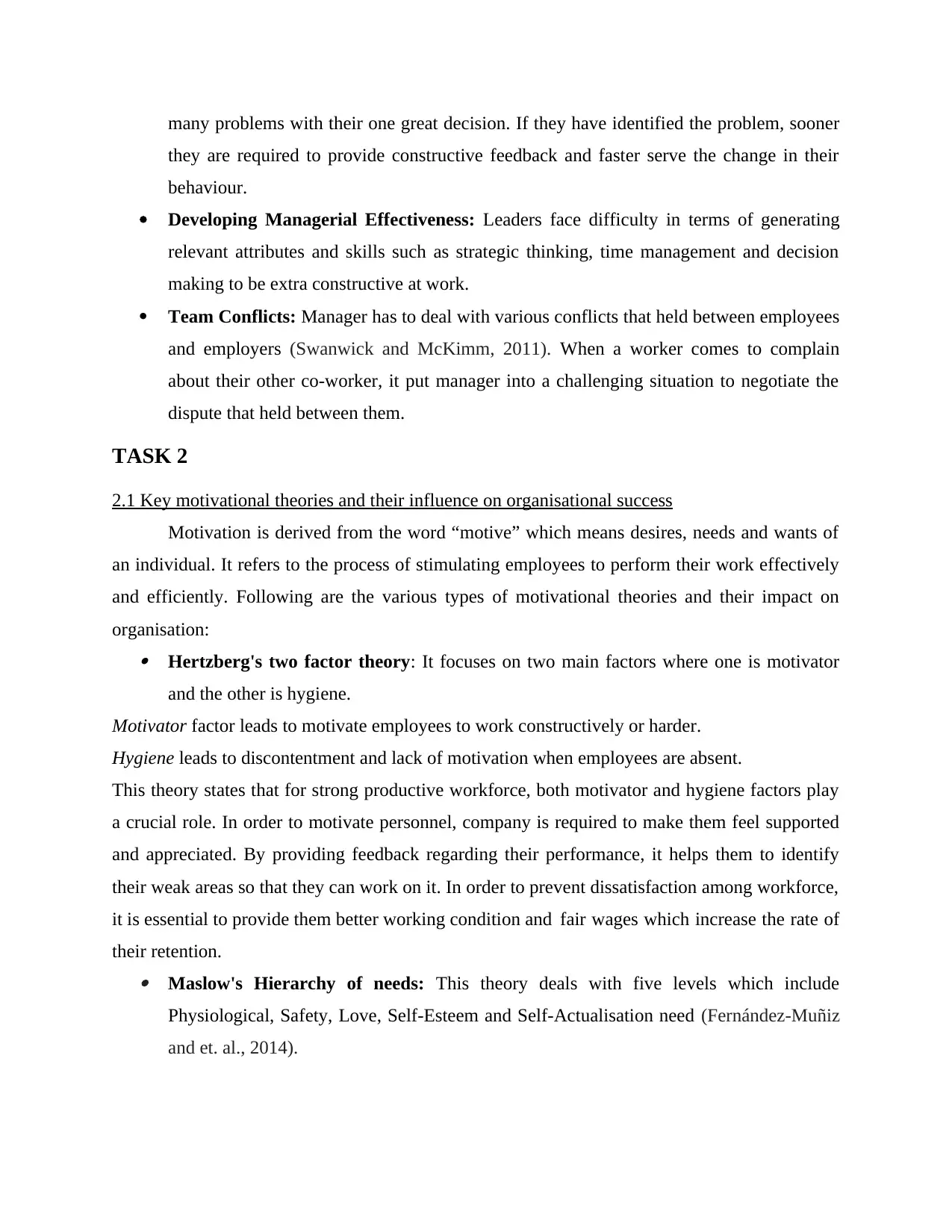
many problems with their one great decision. If they have identified the problem, sooner
they are required to provide constructive feedback and faster serve the change in their
behaviour.
Developing Managerial Effectiveness: Leaders face difficulty in terms of generating
relevant attributes and skills such as strategic thinking, time management and decision
making to be extra constructive at work.
Team Conflicts: Manager has to deal with various conflicts that held between employees
and employers (Swanwick and McKimm, 2011). When a worker comes to complain
about their other co-worker, it put manager into a challenging situation to negotiate the
dispute that held between them.
TASK 2
2.1 Key motivational theories and their influence on organisational success
Motivation is derived from the word “motive” which means desires, needs and wants of
an individual. It refers to the process of stimulating employees to perform their work effectively
and efficiently. Following are the various types of motivational theories and their impact on
organisation: Hertzberg's two factor theory: It focuses on two main factors where one is motivator
and the other is hygiene.
Motivator factor leads to motivate employees to work constructively or harder.
Hygiene leads to discontentment and lack of motivation when employees are absent.
This theory states that for strong productive workforce, both motivator and hygiene factors play
a crucial role. In order to motivate personnel, company is required to make them feel supported
and appreciated. By providing feedback regarding their performance, it helps them to identify
their weak areas so that they can work on it. In order to prevent dissatisfaction among workforce,
it is essential to provide them better working condition and fair wages which increase the rate of
their retention. Maslow's Hierarchy of needs: This theory deals with five levels which include
Physiological, Safety, Love, Self-Esteem and Self-Actualisation need (Fernández-Muñiz
and et. al., 2014).
they are required to provide constructive feedback and faster serve the change in their
behaviour.
Developing Managerial Effectiveness: Leaders face difficulty in terms of generating
relevant attributes and skills such as strategic thinking, time management and decision
making to be extra constructive at work.
Team Conflicts: Manager has to deal with various conflicts that held between employees
and employers (Swanwick and McKimm, 2011). When a worker comes to complain
about their other co-worker, it put manager into a challenging situation to negotiate the
dispute that held between them.
TASK 2
2.1 Key motivational theories and their influence on organisational success
Motivation is derived from the word “motive” which means desires, needs and wants of
an individual. It refers to the process of stimulating employees to perform their work effectively
and efficiently. Following are the various types of motivational theories and their impact on
organisation: Hertzberg's two factor theory: It focuses on two main factors where one is motivator
and the other is hygiene.
Motivator factor leads to motivate employees to work constructively or harder.
Hygiene leads to discontentment and lack of motivation when employees are absent.
This theory states that for strong productive workforce, both motivator and hygiene factors play
a crucial role. In order to motivate personnel, company is required to make them feel supported
and appreciated. By providing feedback regarding their performance, it helps them to identify
their weak areas so that they can work on it. In order to prevent dissatisfaction among workforce,
it is essential to provide them better working condition and fair wages which increase the rate of
their retention. Maslow's Hierarchy of needs: This theory deals with five levels which include
Physiological, Safety, Love, Self-Esteem and Self-Actualisation need (Fernández-Muñiz
and et. al., 2014).
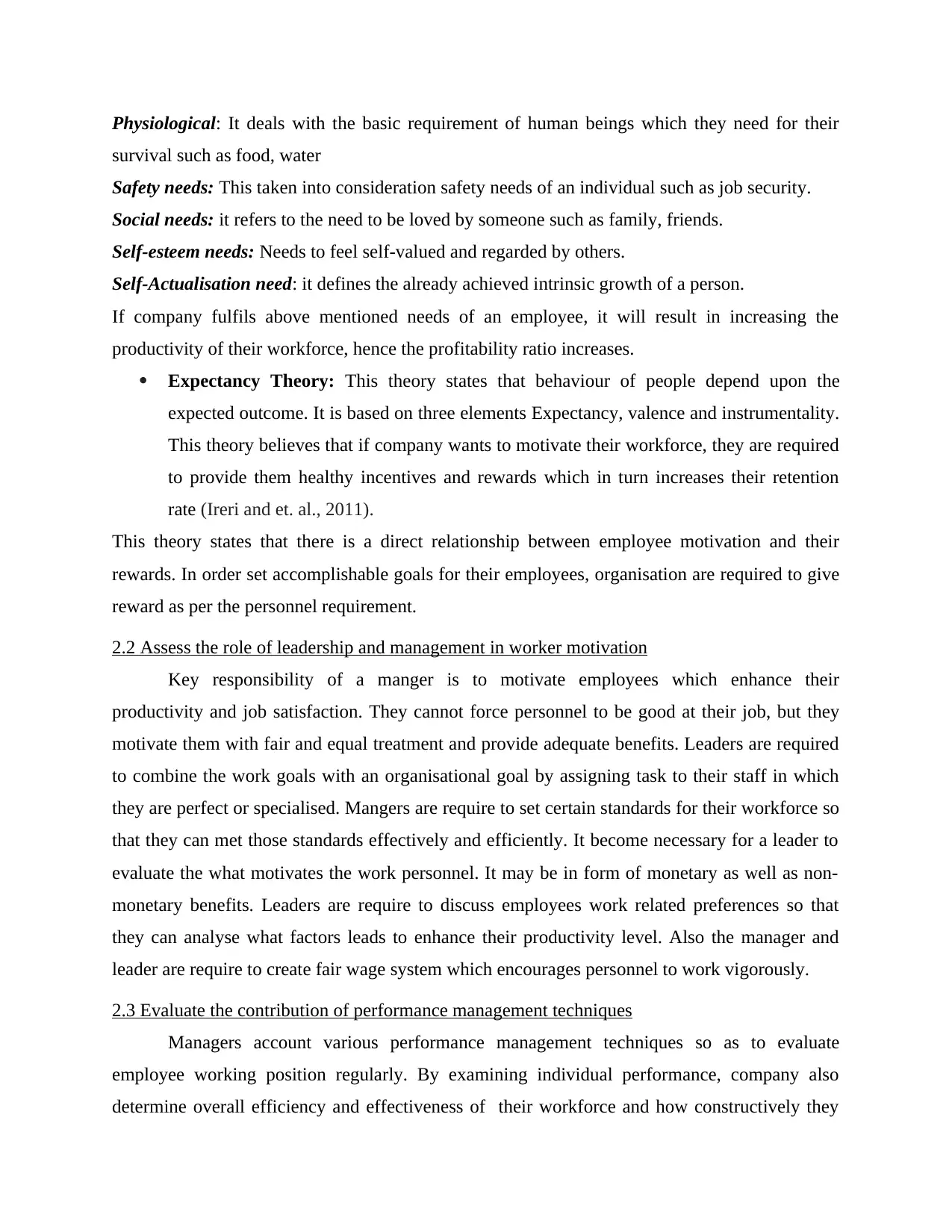
Physiological: It deals with the basic requirement of human beings which they need for their
survival such as food, water
Safety needs: This taken into consideration safety needs of an individual such as job security.
Social needs: it refers to the need to be loved by someone such as family, friends.
Self-esteem needs: Needs to feel self-valued and regarded by others.
Self-Actualisation need: it defines the already achieved intrinsic growth of a person.
If company fulfils above mentioned needs of an employee, it will result in increasing the
productivity of their workforce, hence the profitability ratio increases.
Expectancy Theory: This theory states that behaviour of people depend upon the
expected outcome. It is based on three elements Expectancy, valence and instrumentality.
This theory believes that if company wants to motivate their workforce, they are required
to provide them healthy incentives and rewards which in turn increases their retention
rate (Ireri and et. al., 2011).
This theory states that there is a direct relationship between employee motivation and their
rewards. In order set accomplishable goals for their employees, organisation are required to give
reward as per the personnel requirement.
2.2 Assess the role of leadership and management in worker motivation
Key responsibility of a manger is to motivate employees which enhance their
productivity and job satisfaction. They cannot force personnel to be good at their job, but they
motivate them with fair and equal treatment and provide adequate benefits. Leaders are required
to combine the work goals with an organisational goal by assigning task to their staff in which
they are perfect or specialised. Mangers are require to set certain standards for their workforce so
that they can met those standards effectively and efficiently. It become necessary for a leader to
evaluate the what motivates the work personnel. It may be in form of monetary as well as non-
monetary benefits. Leaders are require to discuss employees work related preferences so that
they can analyse what factors leads to enhance their productivity level. Also the manager and
leader are require to create fair wage system which encourages personnel to work vigorously.
2.3 Evaluate the contribution of performance management techniques
Managers account various performance management techniques so as to evaluate
employee working position regularly. By examining individual performance, company also
determine overall efficiency and effectiveness of their workforce and how constructively they
survival such as food, water
Safety needs: This taken into consideration safety needs of an individual such as job security.
Social needs: it refers to the need to be loved by someone such as family, friends.
Self-esteem needs: Needs to feel self-valued and regarded by others.
Self-Actualisation need: it defines the already achieved intrinsic growth of a person.
If company fulfils above mentioned needs of an employee, it will result in increasing the
productivity of their workforce, hence the profitability ratio increases.
Expectancy Theory: This theory states that behaviour of people depend upon the
expected outcome. It is based on three elements Expectancy, valence and instrumentality.
This theory believes that if company wants to motivate their workforce, they are required
to provide them healthy incentives and rewards which in turn increases their retention
rate (Ireri and et. al., 2011).
This theory states that there is a direct relationship between employee motivation and their
rewards. In order set accomplishable goals for their employees, organisation are required to give
reward as per the personnel requirement.
2.2 Assess the role of leadership and management in worker motivation
Key responsibility of a manger is to motivate employees which enhance their
productivity and job satisfaction. They cannot force personnel to be good at their job, but they
motivate them with fair and equal treatment and provide adequate benefits. Leaders are required
to combine the work goals with an organisational goal by assigning task to their staff in which
they are perfect or specialised. Mangers are require to set certain standards for their workforce so
that they can met those standards effectively and efficiently. It become necessary for a leader to
evaluate the what motivates the work personnel. It may be in form of monetary as well as non-
monetary benefits. Leaders are require to discuss employees work related preferences so that
they can analyse what factors leads to enhance their productivity level. Also the manager and
leader are require to create fair wage system which encourages personnel to work vigorously.
2.3 Evaluate the contribution of performance management techniques
Managers account various performance management techniques so as to evaluate
employee working position regularly. By examining individual performance, company also
determine overall efficiency and effectiveness of their workforce and how constructively they
⊘ This is a preview!⊘
Do you want full access?
Subscribe today to unlock all pages.

Trusted by 1+ million students worldwide
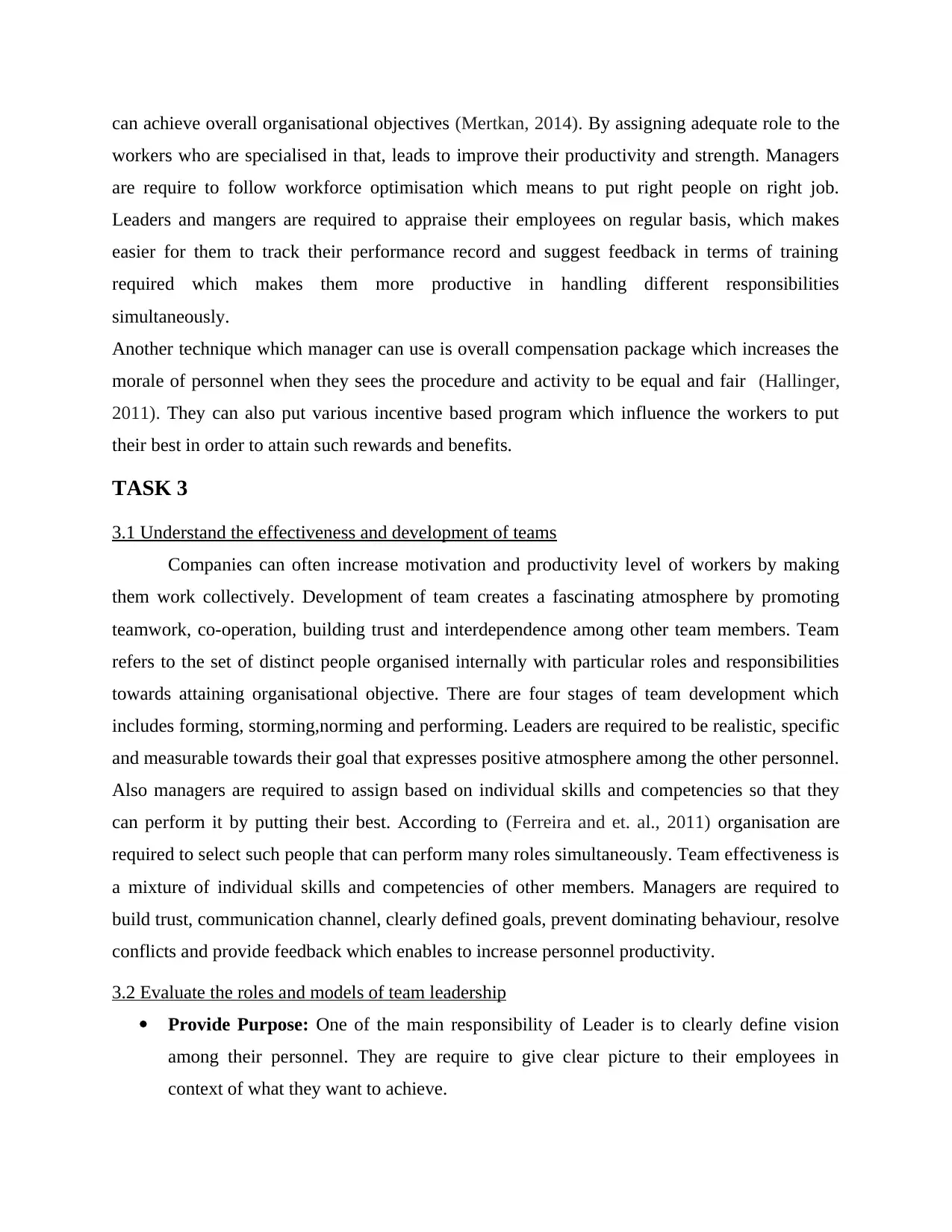
can achieve overall organisational objectives (Mertkan, 2014). By assigning adequate role to the
workers who are specialised in that, leads to improve their productivity and strength. Managers
are require to follow workforce optimisation which means to put right people on right job.
Leaders and mangers are required to appraise their employees on regular basis, which makes
easier for them to track their performance record and suggest feedback in terms of training
required which makes them more productive in handling different responsibilities
simultaneously.
Another technique which manager can use is overall compensation package which increases the
morale of personnel when they sees the procedure and activity to be equal and fair (Hallinger,
2011). They can also put various incentive based program which influence the workers to put
their best in order to attain such rewards and benefits.
TASK 3
3.1 Understand the effectiveness and development of teams
Companies can often increase motivation and productivity level of workers by making
them work collectively. Development of team creates a fascinating atmosphere by promoting
teamwork, co-operation, building trust and interdependence among other team members. Team
refers to the set of distinct people organised internally with particular roles and responsibilities
towards attaining organisational objective. There are four stages of team development which
includes forming, storming,norming and performing. Leaders are required to be realistic, specific
and measurable towards their goal that expresses positive atmosphere among the other personnel.
Also managers are required to assign based on individual skills and competencies so that they
can perform it by putting their best. According to (Ferreira and et. al., 2011) organisation are
required to select such people that can perform many roles simultaneously. Team effectiveness is
a mixture of individual skills and competencies of other members. Managers are required to
build trust, communication channel, clearly defined goals, prevent dominating behaviour, resolve
conflicts and provide feedback which enables to increase personnel productivity.
3.2 Evaluate the roles and models of team leadership
Provide Purpose: One of the main responsibility of Leader is to clearly define vision
among their personnel. They are require to give clear picture to their employees in
context of what they want to achieve.
workers who are specialised in that, leads to improve their productivity and strength. Managers
are require to follow workforce optimisation which means to put right people on right job.
Leaders and mangers are required to appraise their employees on regular basis, which makes
easier for them to track their performance record and suggest feedback in terms of training
required which makes them more productive in handling different responsibilities
simultaneously.
Another technique which manager can use is overall compensation package which increases the
morale of personnel when they sees the procedure and activity to be equal and fair (Hallinger,
2011). They can also put various incentive based program which influence the workers to put
their best in order to attain such rewards and benefits.
TASK 3
3.1 Understand the effectiveness and development of teams
Companies can often increase motivation and productivity level of workers by making
them work collectively. Development of team creates a fascinating atmosphere by promoting
teamwork, co-operation, building trust and interdependence among other team members. Team
refers to the set of distinct people organised internally with particular roles and responsibilities
towards attaining organisational objective. There are four stages of team development which
includes forming, storming,norming and performing. Leaders are required to be realistic, specific
and measurable towards their goal that expresses positive atmosphere among the other personnel.
Also managers are required to assign based on individual skills and competencies so that they
can perform it by putting their best. According to (Ferreira and et. al., 2011) organisation are
required to select such people that can perform many roles simultaneously. Team effectiveness is
a mixture of individual skills and competencies of other members. Managers are required to
build trust, communication channel, clearly defined goals, prevent dominating behaviour, resolve
conflicts and provide feedback which enables to increase personnel productivity.
3.2 Evaluate the roles and models of team leadership
Provide Purpose: One of the main responsibility of Leader is to clearly define vision
among their personnel. They are require to give clear picture to their employees in
context of what they want to achieve.
Paraphrase This Document
Need a fresh take? Get an instant paraphrase of this document with our AI Paraphraser
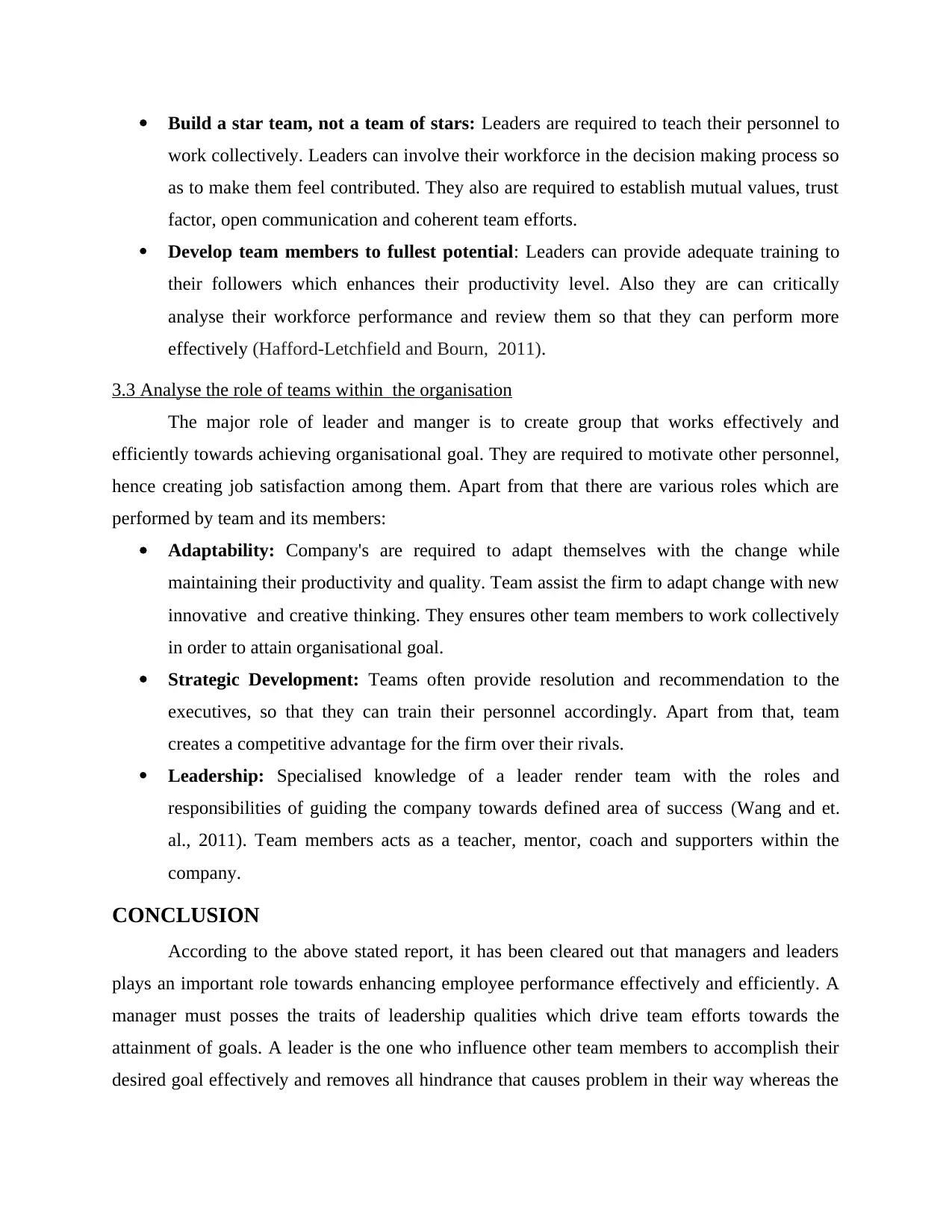
Build a star team, not a team of stars: Leaders are required to teach their personnel to
work collectively. Leaders can involve their workforce in the decision making process so
as to make them feel contributed. They also are required to establish mutual values, trust
factor, open communication and coherent team efforts.
Develop team members to fullest potential: Leaders can provide adequate training to
their followers which enhances their productivity level. Also they are can critically
analyse their workforce performance and review them so that they can perform more
effectively (Hafford-Letchfield and Bourn, 2011).
3.3 Analyse the role of teams within the organisation
The major role of leader and manger is to create group that works effectively and
efficiently towards achieving organisational goal. They are required to motivate other personnel,
hence creating job satisfaction among them. Apart from that there are various roles which are
performed by team and its members:
Adaptability: Company's are required to adapt themselves with the change while
maintaining their productivity and quality. Team assist the firm to adapt change with new
innovative and creative thinking. They ensures other team members to work collectively
in order to attain organisational goal.
Strategic Development: Teams often provide resolution and recommendation to the
executives, so that they can train their personnel accordingly. Apart from that, team
creates a competitive advantage for the firm over their rivals.
Leadership: Specialised knowledge of a leader render team with the roles and
responsibilities of guiding the company towards defined area of success (Wang and et.
al., 2011). Team members acts as a teacher, mentor, coach and supporters within the
company.
CONCLUSION
According to the above stated report, it has been cleared out that managers and leaders
plays an important role towards enhancing employee performance effectively and efficiently. A
manager must posses the traits of leadership qualities which drive team efforts towards the
attainment of goals. A leader is the one who influence other team members to accomplish their
desired goal effectively and removes all hindrance that causes problem in their way whereas the
work collectively. Leaders can involve their workforce in the decision making process so
as to make them feel contributed. They also are required to establish mutual values, trust
factor, open communication and coherent team efforts.
Develop team members to fullest potential: Leaders can provide adequate training to
their followers which enhances their productivity level. Also they are can critically
analyse their workforce performance and review them so that they can perform more
effectively (Hafford-Letchfield and Bourn, 2011).
3.3 Analyse the role of teams within the organisation
The major role of leader and manger is to create group that works effectively and
efficiently towards achieving organisational goal. They are required to motivate other personnel,
hence creating job satisfaction among them. Apart from that there are various roles which are
performed by team and its members:
Adaptability: Company's are required to adapt themselves with the change while
maintaining their productivity and quality. Team assist the firm to adapt change with new
innovative and creative thinking. They ensures other team members to work collectively
in order to attain organisational goal.
Strategic Development: Teams often provide resolution and recommendation to the
executives, so that they can train their personnel accordingly. Apart from that, team
creates a competitive advantage for the firm over their rivals.
Leadership: Specialised knowledge of a leader render team with the roles and
responsibilities of guiding the company towards defined area of success (Wang and et.
al., 2011). Team members acts as a teacher, mentor, coach and supporters within the
company.
CONCLUSION
According to the above stated report, it has been cleared out that managers and leaders
plays an important role towards enhancing employee performance effectively and efficiently. A
manager must posses the traits of leadership qualities which drive team efforts towards the
attainment of goals. A leader is the one who influence other team members to accomplish their
desired goal effectively and removes all hindrance that causes problem in their way whereas the
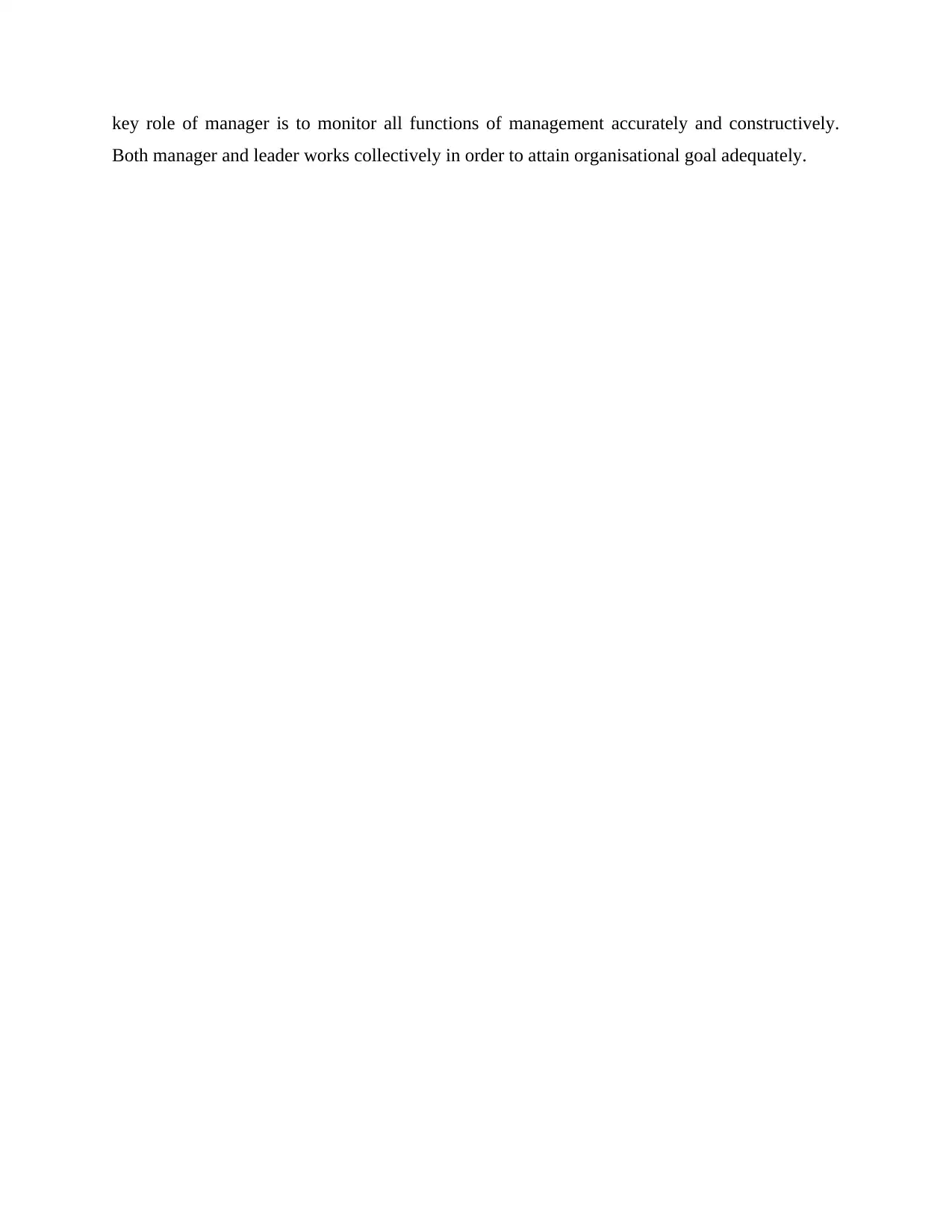
key role of manager is to monitor all functions of management accurately and constructively.
Both manager and leader works collectively in order to attain organisational goal adequately.
Both manager and leader works collectively in order to attain organisational goal adequately.
⊘ This is a preview!⊘
Do you want full access?
Subscribe today to unlock all pages.

Trusted by 1+ million students worldwide
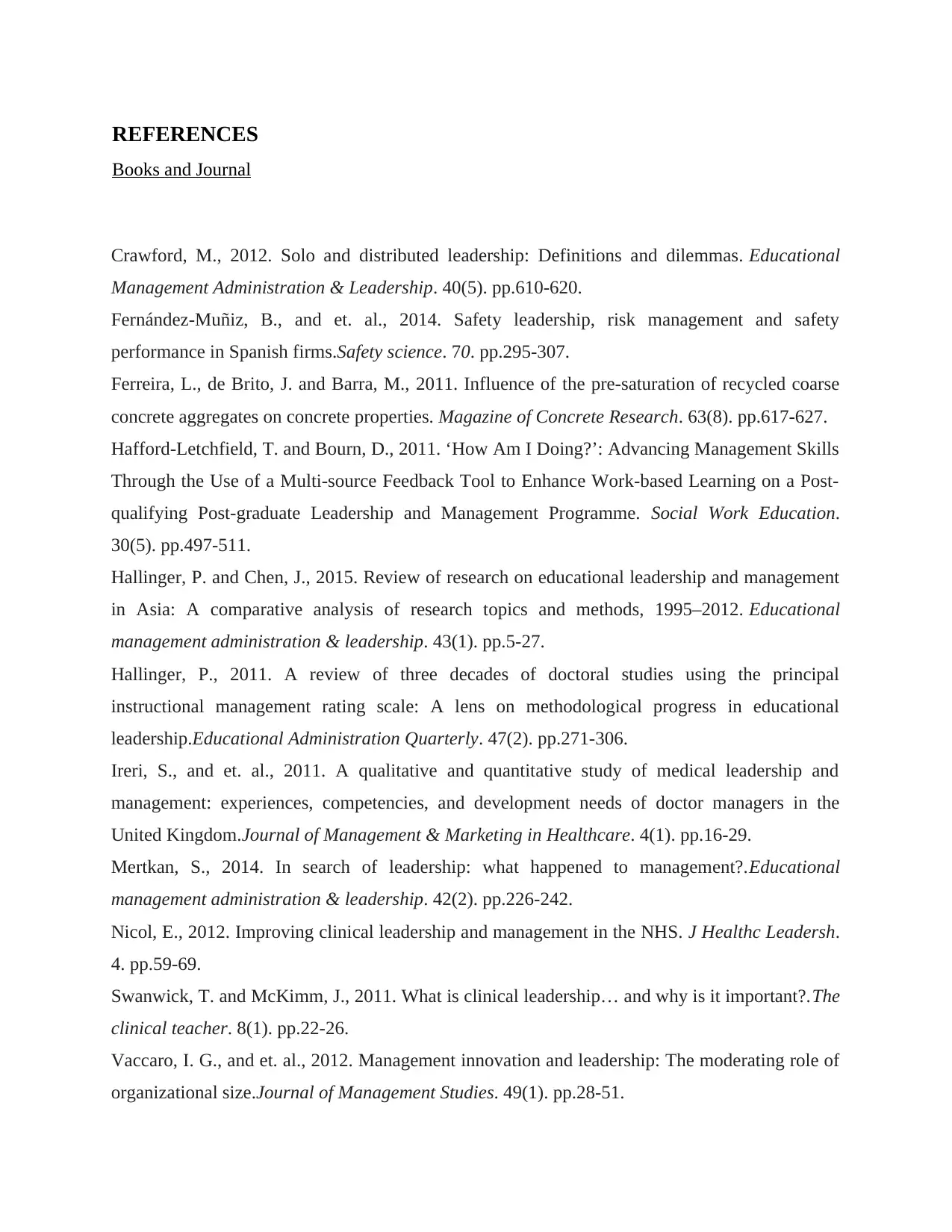
REFERENCES
Books and Journal
Crawford, M., 2012. Solo and distributed leadership: Definitions and dilemmas. Educational
Management Administration & Leadership. 40(5). pp.610-620.
Fernández-Muñiz, B., and et. al., 2014. Safety leadership, risk management and safety
performance in Spanish firms.Safety science. 70. pp.295-307.
Ferreira, L., de Brito, J. and Barra, M., 2011. Influence of the pre-saturation of recycled coarse
concrete aggregates on concrete properties. Magazine of Concrete Research. 63(8). pp.617-627.
Hafford-Letchfield, T. and Bourn, D., 2011. ‘How Am I Doing?’: Advancing Management Skills
Through the Use of a Multi-source Feedback Tool to Enhance Work-based Learning on a Post-
qualifying Post-graduate Leadership and Management Programme. Social Work Education.
30(5). pp.497-511.
Hallinger, P. and Chen, J., 2015. Review of research on educational leadership and management
in Asia: A comparative analysis of research topics and methods, 1995–2012. Educational
management administration & leadership. 43(1). pp.5-27.
Hallinger, P., 2011. A review of three decades of doctoral studies using the principal
instructional management rating scale: A lens on methodological progress in educational
leadership.Educational Administration Quarterly. 47(2). pp.271-306.
Ireri, S., and et. al., 2011. A qualitative and quantitative study of medical leadership and
management: experiences, competencies, and development needs of doctor managers in the
United Kingdom.Journal of Management & Marketing in Healthcare. 4(1). pp.16-29.
Mertkan, S., 2014. In search of leadership: what happened to management?.Educational
management administration & leadership. 42(2). pp.226-242.
Nicol, E., 2012. Improving clinical leadership and management in the NHS. J Healthc Leadersh.
4. pp.59-69.
Swanwick, T. and McKimm, J., 2011. What is clinical leadership… and why is it important?.The
clinical teacher. 8(1). pp.22-26.
Vaccaro, I. G., and et. al., 2012. Management innovation and leadership: The moderating role of
organizational size.Journal of Management Studies. 49(1). pp.28-51.
Books and Journal
Crawford, M., 2012. Solo and distributed leadership: Definitions and dilemmas. Educational
Management Administration & Leadership. 40(5). pp.610-620.
Fernández-Muñiz, B., and et. al., 2014. Safety leadership, risk management and safety
performance in Spanish firms.Safety science. 70. pp.295-307.
Ferreira, L., de Brito, J. and Barra, M., 2011. Influence of the pre-saturation of recycled coarse
concrete aggregates on concrete properties. Magazine of Concrete Research. 63(8). pp.617-627.
Hafford-Letchfield, T. and Bourn, D., 2011. ‘How Am I Doing?’: Advancing Management Skills
Through the Use of a Multi-source Feedback Tool to Enhance Work-based Learning on a Post-
qualifying Post-graduate Leadership and Management Programme. Social Work Education.
30(5). pp.497-511.
Hallinger, P. and Chen, J., 2015. Review of research on educational leadership and management
in Asia: A comparative analysis of research topics and methods, 1995–2012. Educational
management administration & leadership. 43(1). pp.5-27.
Hallinger, P., 2011. A review of three decades of doctoral studies using the principal
instructional management rating scale: A lens on methodological progress in educational
leadership.Educational Administration Quarterly. 47(2). pp.271-306.
Ireri, S., and et. al., 2011. A qualitative and quantitative study of medical leadership and
management: experiences, competencies, and development needs of doctor managers in the
United Kingdom.Journal of Management & Marketing in Healthcare. 4(1). pp.16-29.
Mertkan, S., 2014. In search of leadership: what happened to management?.Educational
management administration & leadership. 42(2). pp.226-242.
Nicol, E., 2012. Improving clinical leadership and management in the NHS. J Healthc Leadersh.
4. pp.59-69.
Swanwick, T. and McKimm, J., 2011. What is clinical leadership… and why is it important?.The
clinical teacher. 8(1). pp.22-26.
Vaccaro, I. G., and et. al., 2012. Management innovation and leadership: The moderating role of
organizational size.Journal of Management Studies. 49(1). pp.28-51.
Paraphrase This Document
Need a fresh take? Get an instant paraphrase of this document with our AI Paraphraser
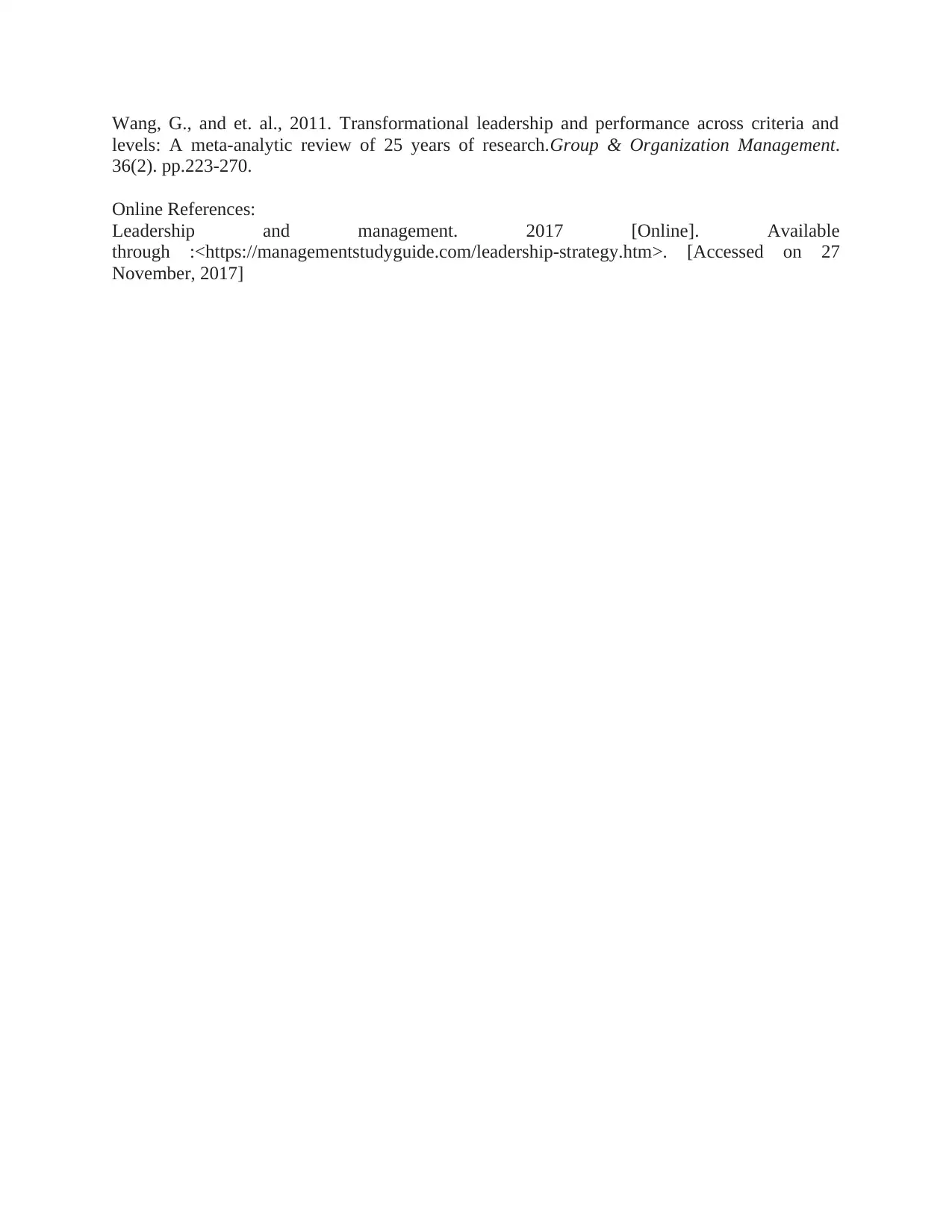
Wang, G., and et. al., 2011. Transformational leadership and performance across criteria and
levels: A meta-analytic review of 25 years of research.Group & Organization Management.
36(2). pp.223-270.
Online References:
Leadership and management. 2017 [Online]. Available
through :<https://managementstudyguide.com/leadership-strategy.htm>. [Accessed on 27
November, 2017]
levels: A meta-analytic review of 25 years of research.Group & Organization Management.
36(2). pp.223-270.
Online References:
Leadership and management. 2017 [Online]. Available
through :<https://managementstudyguide.com/leadership-strategy.htm>. [Accessed on 27
November, 2017]
1 out of 11
Related Documents
Your All-in-One AI-Powered Toolkit for Academic Success.
+13062052269
info@desklib.com
Available 24*7 on WhatsApp / Email
![[object Object]](/_next/static/media/star-bottom.7253800d.svg)
Unlock your academic potential
Copyright © 2020–2025 A2Z Services. All Rights Reserved. Developed and managed by ZUCOL.





